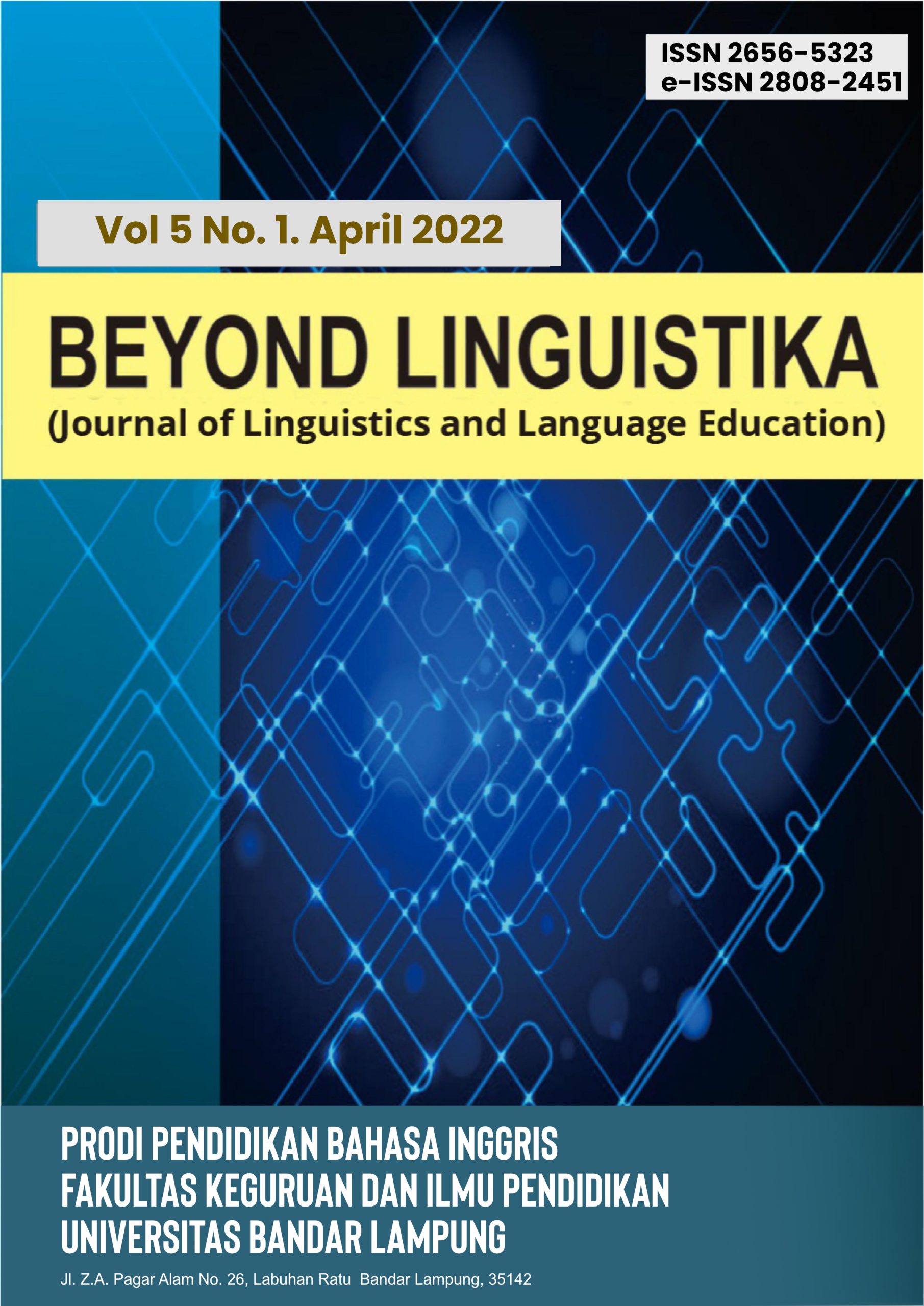An Analysis of English Teachers' Strategies for Enhancing Reading Comprehension
Abstract
Keywords
Full Text:
PDFReferences
Anggreyni, G., & Baluqiah, K. (2022). An analysis of an English textbook “English in mind second edition-students’’ book 3" for the tenth grade of the vocational high school based on ur’s criteria.” Teaching English and Language Learning English Journal (TELLE), 02(02), 128–137. https://doi.org/10.36085/telle.v2i2.3767
Arulogun, O. T., Akande, O. N., Akindele, A. T., & Badmus, T. A. (2020). Survey dataset on open and distance learning students’ intention to use social media and emerging technologies for online facilitation. Data in
Brief, 31, 105929. https://doi.org/https://doi.org/10.1016/j.dib. 2020.105929
Bernard, R. M., Borokhovski, E., Schmid, R. F., Waddington, D. I., & Pickup, D. I. (2019). Twenty-first century adaptive teaching and individualized learning operationalized as specific blends of student-centered instructional events: A systematic review and meta-analysis. Campbell Systematic Reviews, 15(1–2), e1017. https://doi.org/https://doi.org/10.1002/cl2.1017
Berry, R. A. W. (2006). Teacher talk during whole–class lessons: Engagement strategies to support the verbal participation of students with learning disabilities. Learning Disabilities Research & Practice, 21(4),
–232. https://doi.org/10.1111/j.1540-5826.2006.00219.x
Capellini, S. A., Pinto, C. de A. R., & Cunha, V. L. O. (2015). Reading comprehension intervention program for teachers from 3rd grade’ students. Procedia - Social and Behavioral Sciences, 174, 1339–1345. https://doi.org/https://doi.org/10.1016/j.sbs pro.2015.01.756
ChanLin, L. (2007). Perceived importance and manageability of teachers toward the factors of integrating computer technology into classrooms. Innovations in Education and Teaching International, 44(1), 45–55. https://doi.org/10.1080/14703290601090390
Chung, E. (2022). Effecting change in teachers’ epistemological and pedagogical beliefs about vocabulary learning and teaching: The role of dialogic reflection. Sage Open, 12(1), 21582440211071084. https://doi.org/10.1177/21582440211071084
Cuban, L. (2006). Getting past futile pedagogical wars. Phi Delta Kappan, 87(10), 793–795. https://doi.org/10.1177/003172170608701017
Daniels, D. H., & Perry, K. E. (2003). “Learnercentered” according to children. Theory Into Practice, 42(2), 102–108. https://doi.org/10.1207/s15430421tip4202_3
Davis, D. S., Bippert, K., & Villarreal, L. (2015). Instructional tendencies in the teaching of reading comprehension: a portrait of practice in the measures of effective teaching (MET) database. Literacy Research: Theory, Method, and Practice, 64(1), 285–306. https://doi.org/10.1177/2381336915617399
Ertmer, P. A. (2005). Teacher pedagogical beliefs: The final frontier in our quest for technology integration? Educational Technology Research and Development, 53(4), 25–39. https://doi.org/10.1007/BF02504683
Fadilah, R., Ayudhia, H. Y., Pratama, V. M., & Harmawan, V. (2023). Teachers’ teaching reflection: English teachers’ challenges in rural areas of Indonesia. LET: Linguistics, Literature and Language Teaching Journal,
(1), 85–104. http://jurnal.uinantasari.ac.id/index.php
Fisher, M. (2000). Computer skills of initial teacher education students. Journal of Information Technology for Teacher Education, 9(1), 109–123. https://doi.org/10.1080/14759390000200075
Gao, L., & Watkins, D. A. (2002). Conceptions of teaching held by school science teachers in P.R. China: Identification and cross-cultural comparisons. International Journal of Science Education, 24(1), 61–79. https://doi.org/10.1080/09500690110066926
Hall, L. A. (2005). Teachers and content area reading: Attitudes, beliefs and change. Teaching and Teacher Education, 21(4), 403–414. https://doi.org/https://doi.org/10.1016/j.tate.2005.01.009
Hattie, J. A. C., & Donoghue, G. M. (2016). Learning strategies: a synthesis and conceptual model. Npj Science of Learning, 1(1), 16013. https://doi.org/10.1038/npjscilearn.2016.13
Jonassen, D. H. (1985). Learning strategies: A new educational technology. PLET: Programmed Learning & Educational Technology, 22(1), 26–34. https://doi.org/10.1080/1355800850220104
Kissau, S., & Hiller, F. (2013). Reading comprehension strategies: An international comparison of teacher preferences. Research in Comparative and International Education, 8(4), 437–454. https://doi.org/10.2304/rcie.2013.8.4.437
Lenz, B. K. (2006). Creating school-wide conditions for high-quality learning strategy classroom instruction. Intervention in School and Clinic, 41(5), 261–266. https://doi.org/10.1177/10534512060410050201
Masadeh, T. S. Y. (2015). Performance of Saudi English language teachers in reading comprehension classes. Sage Open, 5(4), 2158244015621598. https://doi.org/10.1177/2158244015621598
Nurhasanah, A., Marissa, E., & Mahmudah, F. (2019). The English teacher strategies to enhance students’ speaking performance. Proceedings of the 3rd Asian Education Symposium (AES 2018), 481–485. https://doi.org/10.2991/aes-18.2019.108
Ogunnaike, O. O., Ayeni, B., Olorunyomi, B., Olokundun, M., Ayoade, O., & Borishade, T. (2018). Data set on interactive service quality in higher education marketing. Data in Brief, 19, 1403–1409. https://doi.org/https://doi.org/10.1016/j.dib.2018.05.082
Okagbue, H. I., Oguntunde, P. E., Obasi, E. C. M., & Akhmetshin, E. M. (2021). Trends and usage pattern of SPSS and Minitab Software in Scientific research. Journal of Physics: Conference Series, 1734(1), 012017. https://doi.org/10.1088/1742-6596/1734/1/012017
Pratt, D. D. (2002). Good teaching: One size fits all? New Directions for Adult and Continuing Education, 2002(93), 5–16. https://doi.org/https://doi.org/10.1002/ace.45
Sakolrak, S. (2014). The strategic development to enhance reading comprehension instructional competency of elementary school teachers based on comprehension ability diagnostic instruments. Procedia -Social and Behavioral Sciences, 116, 2946–2951. https://doi.org/https://doi.org/10.1016/j.sbs pro.2014.01.685
Simmons, D., Fogarty, M., Oslund, E. L., Simmons, L., Hairrell, A., Davis, J., Anderson, L., Clemens, N., Vaughn, S., Roberts, G., Stillman, S., & Fall, A.-M. (2014). Integrating content knowledgebuilding and student-regulated comprehension practices in secondary english language arts classes. Journal of Research on Educational Effectiveness, 7(4), 309–330. https://doi.org/10.1080/19345747.2013.836766
Soliman, A. M. (2017). Appropriate teaching and learning strategies for the architectural design process in pedagogic design studios. Frontiers of Architectural Research, 6(2), 204–217. https://doi.org/https://doi.org/10.1016/j.foar.2017.03.002
Suárez, N., Sánchez, C. R., Jiménez, J. E., & Anguera, M. T. (2018). Is reading instruction evidence-based? Analyzing teaching practices using T-Patterns. Frontiers in Psychology, 9(FEB). https://doi.org/10.3389/fpsyg.2018.00007
Tuleja, E. A. (2002). A qualitative research study of oral communication performance. Performance Improvement Quarterly, 15(3), 130–148. https://doi.org/https://doi.org/10.1111/j.1937-8327.2002.tb00260.x
Williams, K. J., & Martinez, L. R. (2019). Supporting reading comprehension for students who are learning English and have learning disabilities. Intervention in School and Clinic, 55(1), 23–31. https://doi.org/10.1177/1053451219833019
DOI: http://dx.doi.org/10.36448/bl.v6i2.3950
Refbacks
- There are currently no refbacks.















